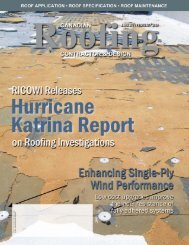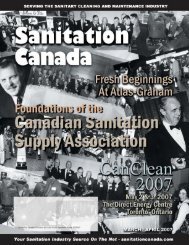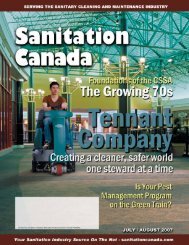here - Perks Publications Inc.
here - Perks Publications Inc.
here - Perks Publications Inc.
You also want an ePaper? Increase the reach of your titles
YUMPU automatically turns print PDFs into web optimized ePapers that Google loves.
special feature<br />
Continued From Page 21<br />
the cost can be high.<br />
• In fact, cost effectiveness is a barrier<br />
that all recycling programs must<br />
overcome before they become practical.<br />
This includes the geography of recycling<br />
– how far, and at what cost,<br />
should recyclable materials be transported<br />
before the environmental tradeoff<br />
becomes negative? Still, most environmentalists<br />
argue that the cost effectiveness<br />
of recycling is a matter of critical<br />
mass – the more we do it, the less<br />
costly it will become.<br />
• The use of recycled content in certain<br />
modified bitumen roofing systems<br />
can also contribute to an overall reduction<br />
of waste going to landfills.<br />
One way of determining if a roof<br />
system is sustainable is whether or not<br />
it qualifies for points under the U.S.<br />
Green Building Council’s LEED Green<br />
Building Rating System. LEED is a<br />
voluntary, consensus-based national<br />
standard for developing high-performance,<br />
sustainable buildings. While<br />
LEED does not certify products, buildings<br />
can earn LEED certification.<br />
Under the current standard, LEED<br />
version 2.2 credit categories include:<br />
• Sustainable Sites<br />
• Stormwater Efficiency<br />
• Energy and Atmosp<strong>here</strong><br />
• Materials and Resources<br />
• Indoor Environmental Quality<br />
• Innovation and Design Process<br />
HPR 2B: ENVIRONMENT/INTERNAL<br />
One of the more neglected aspects<br />
of roofing is the positive impact it can<br />
have on a comfortable, healthy, productive<br />
environment inside buildings,<br />
w<strong>here</strong> many people spend most of their<br />
days. A High-Performance Roofing<br />
system can contribute to a better indoor<br />
environment in two ways:<br />
(1) Cool, green and perhaps solarintegrated<br />
HPR systems help to moderate<br />
indoor temperatures, even in<br />
buildings without air conditioning. A<br />
number of studies have shown a direct<br />
relationship between thermal comfort<br />
and worker productivity in offices and<br />
manufacturing facilities. Comfortable<br />
indoor temperatures have been shown<br />
to improve overall mental concentration,<br />
manual work rates, and manual<br />
dexterity, while reducing accident rates<br />
and absenteeism.<br />
(2) Vented roofing systems can help<br />
reduce moisture and mould while relieving<br />
positive air press, allowing<br />
buildings to “breathe.”<br />
22 Canadian Roofing Contractor & Design - APRIL / MAY 2007<br />
HPR 3: ENDURANCE<br />
Many factors affecting the durability<br />
and longevity of roofing systems<br />
are beyond our control, such<br />
as climate, catastrophic accidents and<br />
violent storms. In terms of High-Performance<br />
Roofing, endurance is the<br />
ultimate reflection of the performance<br />
of every roofing component or<br />
element that can be controlled by intelligent<br />
design, manufacture, installation<br />
and maintenance.<br />
Most green building experts believe<br />
that longevity is among the most important<br />
factors contributing to the<br />
sustainability of any building product,<br />
including roofing systems. Long-lasting










